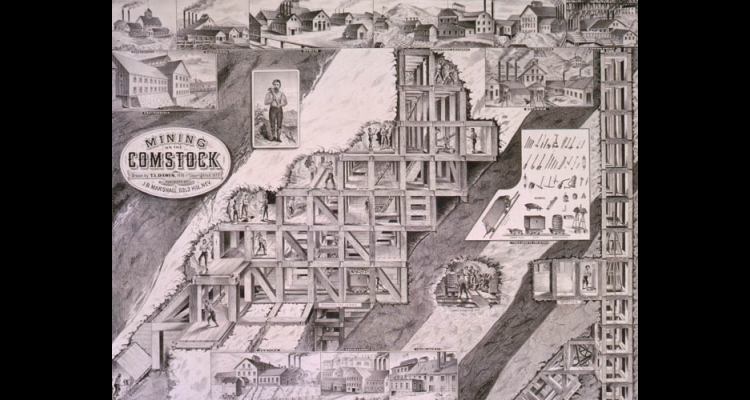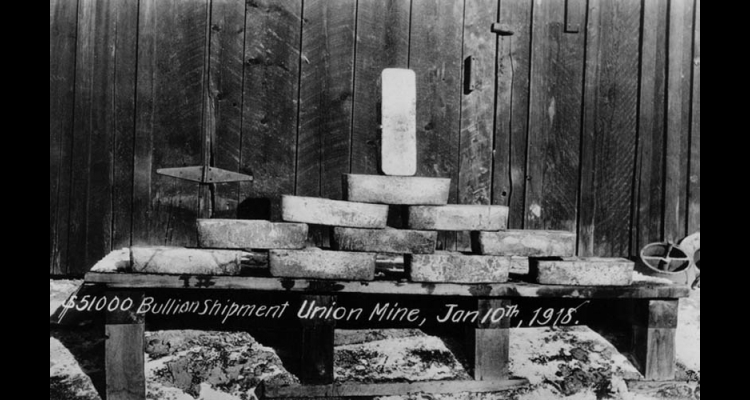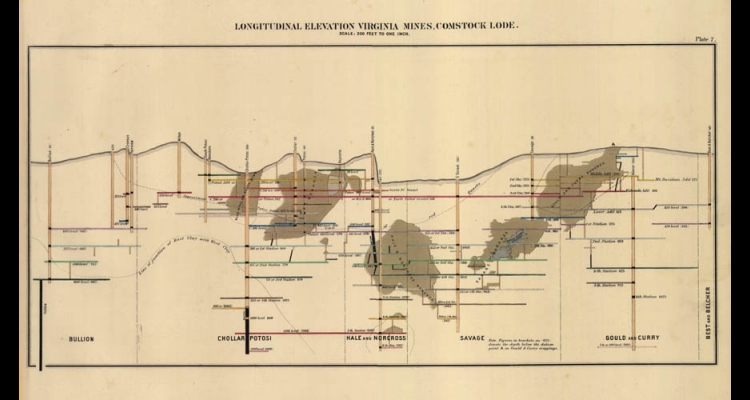Comstock Lode
The Comstock Lode is one of the most important mining discoveries in American history, in output and in significance. It was the first major silver discovery in United States history: of the total ore taken out from the district, best estimates are that 57 per cent was silver, yet it was a considerable gold camp, given that the remaining 42 per cent was of that metal. Certainly it is the most dramatic event in Nevada's nineteenth century history, and, without it, Nevada could not have attained statehood when it did.
The initial discovery was in 1859, and soon the "Rush to Washoe" was in full swing. For the next twenty years the Comstock was the dominating event in Nevada history, and for that matter, of considerable importance in American history. Its history can be broken down into three main periods.
1859-1865: The Years of Litigation. Miners and corporations went to court to fight over mining claim boundaries and whether the lode consisted on only one, continuous vein of ore or splintered into many veins. During this six year period, miners removed an estimated $50 million in ore from the earth, but about $10 million of that sum was spent on litigation. The leaders of the Comstock, such as William Stewart, a politically active mining lawyer who went on to be a U.S. senator, were involved in the ensuing court battles.
1865-1875: The Bank Crowd. Representatives of the Bank of California, based in San Francisco, achieved dominance over the Comstock. Buying on a declining market, the bank, represented by its man in Virginia City, William Sharon, gambled on the district's future and won. It lent out money at two per cent a month, undercutting smaller, less capitalized banks, and when the borrowers defaulted, it acquired mines and mills and hence controlling influence in Virginia City. The Bank Crowd also built the Virginia and Truckee Railroad from the mining area, drastically decreasing transportation costs, and practiced vertical integration, much like such eastern industrialists as steel tycoon Andrew Carnegie and oil titan John D. Rockefeller. Under Sharon's influence, the Bank Crowd took over or started land, water, and freighting companies, cutting costs and increasing profits.
1875-1881: The Bonanza Group. Four Irishmen led by mining superintendents John Mackay and James Fair discovered by far the richest ore bodies in the Comstock in 1873. In the next few years, they imitated Sharon's policies, although Mackay managed to retain the personal popularity in Virginia City that Sharon lacked. After 1878, the bonanza discoveries rather rapidly petered out, and, although the Comstock was to produce ore until the 1940s, it was at a greatly reduced rate.
In total, we are told that from 1859 until 1882, the official amount taken out of the Comstock was $305,779,612.48. But the vast majority of the companies did not prove profitable for the owners. Stockholders received dividends of $115,871,100, but out of 103 mining companies reporting, only fourteen were responsible for this payout. Against that, 102 companies assessed $61,715,535 from shareholders, leaving a net of only $54,155,565 remaining to stockholders. Of the 103 companies, only six ever paid more dividends than they demanded in assessments, and ninety-seven never paid a dividend at all.
Against those overall statistics, the hugeness of the Big Bonanza stands out. From 1873 to 1882, two of the Bonanza Group's adjacent mines produced $105,168,859 worth of ore, of which the four owners received $74,250,000 in dividends. Simply put, only a small portion of the fabulous Virginia City mines was ever particularly profitable.
Another way individuals could become rich (or poor) from the Comstock was through the stock market, where the San Francisco exchange listed the leading stocks. The stocks, to put it mildly, were quite volatile. The Belcher mine illustrates the stock gyrations: a share of Belcher, which listed for $430 in April 1868, had soared to $1,525 in April 1872. By September 1878, the same share was a nearly worthless $2. In 1876, the Comstock's total stock valuation was worth more than the total assessed value of the City of San Francisco, which had over a quarter million people. A few years later the stock was worthless. Certainly one of the Comstock's distinguishing characteristics is that it illustrates the spottiness of the American dream and the variations between rich and poor in nineteenth-century Nevada.
The 1870 and 1880 censuses proved similar, with the 1880 count ranking the various ethnic groups by size: Chinese, Irish, English, Welsh, Canadians, Germans, and Italians. To understand the polyglot population of the Comstock, it is necessary to separate the foreign-born into two discrete groups—the Europeans and the Chinese. Their motivations for coming to the United States were completely different, as were the opportunities and experience they confronted.
European foreign-born dominated mining employment. According to the 1880 census, of 2,770 men involved in the mining industry on the Comstock Lode, only 770 were American born. Of the 2,000 foreign born, Irish led with 816 miners, and 640 were English and Welsh. The Chinese were forbidden because of the universal racism vented toward them to work in the Comstock's mines, which meant that for Virginia City and Gold Hill, they formed a lesser percentage of the population than was true for the rest of the state.
The mobility of the European immigrants in Nevada is astonishing. It is easy to apply eastern stereotypes of anti-immigrant attitudes to the West—stereotypes that include the existence of the Know-Nothing Party in the 1850s, signs in the popular imagination such as "No Irish Need Apply here," and the intense anti-Catholic sentiment prevalent in most areas of the United States. But in Nevada these anti-immigrant attitudes were applied mainly to the Chinese. Many of the most important Comstock leaders and politicians were European by birth. For example, Adolph Sutro was born in Prussia, John P. Jones was born in Wales, and three of the four leaders of the Bonanza Group were born in Ireland.
Why this great mobility where from the beginning the European foreign born could reach the very top of society? From its discovery, the Comstock was an instant society with instant mobility. Thus, no encrusted old guard lived in Nevada (unless one considers Native Americans) to keep the new arrivals down. Nor was there the deep-seated resentment toward Roman Catholicism that so typified the attitudes of the dominant Protestant denominations in the East and South. Nevada, and the Comstock, from the beginning was basically an unchurched, secular society and the biggest denomination by far was the Catholic, because of the great Irish immigration.
The Comstock, in its years of growth, also had a skewed imbalance between the sexes. No state had a greater sex disparity than did Nevada at its beginnings. In 1870, for example, males outnumbered females in Nevada, 32,379 to 10,112, meaning that females numbered only 23.6 per cent of the population. Yet this underemphasizes, in many ways, the discrepancy in the proportion of the population that was male and female, because it includes children. Taking out children (4,394 males and 4,240 females) and the elderly (3,223 males and 579 females) leaves an overwhelmingly male society. Young people and older people were astonishingly underrepresented in the Nevada population. The majority of people were young, single, adult white males.
Another distinguishing characteristic of the Comstock was that it was at the forefront of technological innovation and advancement in its time. Developing the Lode represented a major achievement of applying ideas and inventions of the Industrial Revolution to the age-old practice of mining. This was necessary due to the nature of the ore deposits, buried as they were deep underground, and because Virginia City and Gold Hill were built in an arid region, far from necessary resources on the steep hillside of Mount Davidson. The ore also ran deeply underground. Consequently, grappling with these difficulties required a totally new technology. By 1880, Virginia City's mines were as deep as 2,100 feet below ground level, deeper than any mines anywhere up to that time. The soil of the area does not support itself, so in order to keep the soil from collapsing upon the miners, the brilliant concept of square-set timbering, invented by Philipp Deidesheimer, represented a new way of thinking for shoring up the mines. This concept, unpatented, was to go all around the west. Since Virginia City was too arid to support large forest reserves, necessary wood had to be imported from the Lake Tahoe region, and hauled to the top of Spooner summit by narrow-gauge railway, allowed to float down to the intervening valley floor by J.W. Haines's invention, the V-flume, where water helped flush the timber down. Once it was on the valley floor, the wood was transferred to the Virginia and Truckee Railway, itself one of the Comstock's engineering marvels, where it was transported to supply the square set timbering. Necessary water arrived through pipe laid from the Sierra Nevada into the valleys and then up over the Virginia Range to slake the thirst of the Comstock. The Sutro Tunnel was a brilliantly conceived scheme for draining the excess water found in the mines. When it was finished, its almost four miles of tunnel linking the underground mining with the Carson River valley was an important and most impressive technological achievement.
But from the standpoint of the Comstock and of Nevada, all of this outstanding achievement was quite transitory. The governing principle of the Comstock's owners was to take the ore out as rapidly as possible, to use their financial strength to gain high political office and influence, and, when the ore was gone, to leave the scene permanently. Those leaders of the Comstock who were politically ambitious ran for the United States Senate, rather than local office. It was, after all, far easier and cheaper to bribe a limited group of legislators to gain election to the Senate than to run a statewide race before Nevada voters. Several Comstock leaders went on to the United States Senate: John Jones represented his state for thirty thoroughly undistinguished years; William Stewart, a far more controversial type, for twenty eight. William Sharon was senator for six years, although he rarely showed up for meetings, and was represented on only two per cent of roll-call votes. As historian Russell Elliott notes, Sharon's "only visits to Nevada during his incumbency in the Senate came while passing through the state on his way to or from the east." James Fair was also a U.S. Senator for six years.
And when the ore was gone, the leadership departed. Almost none of the leaders remained in Nevada—rather they took their money and headed elsewhere. After 1880, all of the state's mining centers—not only the Comstock but also Austin, Aurora, Pioche, Eureka, and Treasure Hill—declined with only Delamar, in the southern part of the state, to take their place. With a total population of perhaps 25,000 people at its height, Storey County, which encompassed the Comstock, by 1900 had only 3,560 souls. From 1880 to 1900 the state lost a third of its people, a calamitous loss, especially considering its limited population to begin with. By 1900 Nevada had only a third as many people as the next least populated state—Wyoming. Outside resentment toward Nevada for having two United States senators was one of the factors that led even such a friendly critic as William Smythe to ask, in the Chicago Tribune in 1897, "Should Nevada Remain a State." Certainly, by 1900, the state was an economic and social wreck, destroyed by the precipitous decline of the industry that had given it sustenance to begin with.
Article Locations
Related Articles
None at this time.
Further Reading
None at this time.



